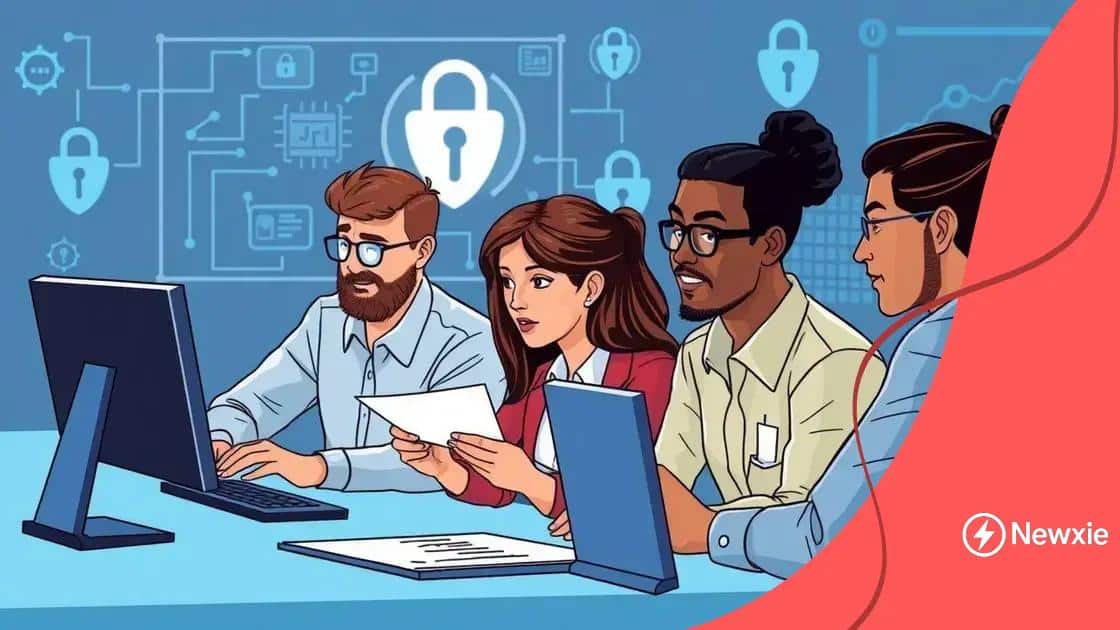Cyberattack prevention strategies: safeguarding your business

Anúncios
Implementing cyberattack prevention strategies includes understanding threats, utilizing protective technologies, training employees, conducting regular audits, and developing an effective incident response plan to minimize risks and enhance cybersecurity resilience.
Cyberattack prevention strategies are crucial in today’s digital landscape, where threats evolve rapidly. Have you ever considered how vulnerable your business might be? Let’s explore effective ways to safeguard your operations.
Anúncios
Understanding the types of cyber threats
In the world of cybersecurity, understanding the different types of cyber threats is essential. These threats evolve constantly, and your ability to recognize them can significantly enhance your organization’s defense.
Common Types of Cyber Threats
Cyber threats can be broadly categorized into several types. Recognizing these categories can help in developing better prevention strategies.
- Malware: Malicious software designed to harm or exploit any programmable device, service, or network.
- Phishing: Deceptive attempts to obtain sensitive information by pretending to be a trustworthy source.
- Ransomware: A type of malware that blocks access to files or a system until a ransom is paid.
- Denial of Service (DoS) attacks: Efforts to make a machine or network resource unavailable to its intended users.
Understanding the landscape of cyber threats is vital for any business today. Each type poses unique risks that require tailored protection approaches. Some may invest in advanced software solutions to combat malware, while others may focus on employee education to combat phishing attacks.
Anúncios
Emerging Cyber Threats
In addition to traditional threats, new ones are constantly emerging. These include attacks that exploit IoT devices, which can be vulnerable due to insufficient security measures. As businesses adopt more connected devices, the risk of these threats increases.
Furthermore, understanding cyber threats is not just about identifying them, but also knowing how to respond effectively. Keeping up with the latest trends, security patches, and robust training for employees are essential steps in creating a resilient defense.
Key protective technologies to implement
To combat the ever-evolving landscape of cyber threats, businesses must adopt key protective technologies. These technologies provide a robust backbone for any cybersecurity strategy, helping to safeguard sensitive data and protect against attacks.
Firewalls
A firewall acts as a barrier between your internal network and external threats. It monitors incoming and outgoing traffic and can block harmful data packets. Investing in advanced firewall solutions keeps your network much safer.
- Next-Generation Firewalls (NGFW): These offer features beyond traditional firewalls, including intrusion prevention and application awareness.
- Web Application Firewalls (WAF): These specifically protect web applications by filtering and monitoring HTTP traffic.
- Cloud Firewalls: Designed for cloud environments, these provide scalable protection.
In addition to firewalls, another essential component is anti-virus software. This technology detects and removes malicious software from your systems. Regular updates and scans ensure your systems remain protected from new threats. It’s vital to choose a solution that offers real-time protection to catch threats as they emerge.
Intrusion Detection Systems (IDS)
Intrusion detection systems monitor network traffic for suspicious activity. An IDS can alert administrators of potential security breaches, allowing for timely interventions. This proactive approach is crucial in minimizing damage from attacks.
Also, consider the implementation of encryption technologies. Encryption protects sensitive data by converting it into a code, making it unreadable to unauthorized users. Without proper encryption, even the strongest networks can fall victim to breaches.
Multi-Factor Authentication (MFA)
Adopting multi-factor authentication adds an extra layer of security. By requiring multiple forms of verification, such as a password and biometric data, businesses can mitigate the risk of unauthorized access. MFA is particularly important for remote access to systems.
Ultimately, investing in these key protective technologies is not just about compliance; it’s about protecting your valuable assets and ensuring business continuity. By staying ahead with robust security measures, organizations can significantly reduce their vulnerability.
Best practices for employee training

Training employees on cybersecurity is critical in reinforcing your organization’s defenses. Implementing best practices for employee training can empower staff to recognize and properly respond to threats.
Regular Training Sessions
Conducting regular training sessions helps keep security top of mind. Schedule these sessions at least once a year or when there are major updates in security policies. Short, interactive training modules can be particularly effective.
- Simulated Phishing Exercises: Run regular phishing simulations to help employees identify suspicious emails.
- Hands-On Workshops: Offer practical workshops focused on using security tools and understanding threats.
- Continuous Learning: Encourage self-paced learning through online courses or webinars.
In addition to scheduled training, consider creating a culture of awareness around cybersecurity. Encourage employees to share information about threats they encounter. This open dialogue fosters a team approach to security.
Clear Security Policies
It’s vital to establish clear security policies that outline employee responsibilities. Make sure all employees understand the importance of adhering to these policies. Regularly reviewing and updating the policy documents ensures that everyone is on the same page.
Utilizing visual aids can also enhance understanding. Infographics and quick-reference guides can simplify complex topics and serve as helpful reminders.
Feedback Mechanisms
After training sessions, solicit feedback from employees. Understanding their challenges and suggestions can help improve future training programs. This feedback loop is crucial in adapting your approach to meet the needs of your team.
Ultimately, integrating these best practices for employee training creates a more informed and vigilant workforce. By prioritizing education and open communication about cybersecurity, organizations can significantly strengthen their defenses against potential threats.
Importance of regular security audits
Regular security audits are vital for any organization aiming to protect its data and assets. These audits help identify vulnerabilities in your systems before they can be exploited by malicious actors.
What is a Security Audit?
A security audit involves reviewing your organization’s information systems to assess their security posture. It includes evaluating policies, procedures, and technical controls. This process helps in understanding how well your organization is equipped to defend against cyber threats.
- Compliance: Regular audits ensure compliance with industry regulations and standards, which is crucial for maintaining credibility and trust.
- Risk Management: They help in identifying potential risks and vulnerabilities, allowing you to address them promptly.
- Policy Effectiveness: Audits can assess whether existing security policies and measures are effective in protecting against threats.
Conducting security audits regularly fosters a proactive approach to cybersecurity. Rather than waiting for incidents to occur, organizations can implement changes to enhance their defenses. With evolving threats, staying ahead is critical.
Components of a Security Audit
Key components of a security audit include network security assessments, application security checks, and physical security evaluations. Assessing these areas highlights weaknesses that need attention. For example, checking for outdated software can prevent vulnerabilities from being exploited.
In addition, engaging third-party experts for audits can bring fresh perspectives. They may identify risks and issues your internal team might overlook. This outside perspective is invaluable in creating a comprehensive security strategy.
Ongoing Improvement
The goal of regular security audits is not just to find issues but to foster ongoing improvement. After each audit, it’s essential to document findings and develop action plans. Regular follow-ups on these plans ensure that weaknesses are addressed effectively, reinforcing a culture of security awareness within the organization.
Ultimately, prioritizing the importance of regular security audits leads to stronger defenses and increased resilience against cyber threats. Keeping your systems up-to-date and secure requires continuous effort and vigilance.
Developing an incident response plan
Developing an incident response plan is a crucial step for any organization that wants to minimize damage from cyber incidents. This plan outlines the steps to take when a security breach occurs and helps ensure a swift response.
Understanding the Components
An effective incident response plan includes several key components. Knowing these elements ensures your organization is prepared for any situation.
- Preparation: This involves having the right tools, technologies, and trained personnel in place.
- Identification: Knowing how to detect incidents quickly helps limit the impact. Clear guidelines on what constitutes an incident should be included.
- Containment: Immediate actions must be taken to contain the impact of the incident and prevent further damage.
- Eradication: Once contained, it’s essential to identify the root cause and eliminate the threat.
- Recovery: Restoring systems to normal operation while ensuring that vulnerabilities are addressed is crucial for future security.
Communication is another essential aspect of an incident response plan. Designate a team responsible for communicating with stakeholders, including employees, customers, and authorities if necessary. Having a clear communication strategy helps manage the situation effectively.
Regular Testing and Updates
It’s vital to test your incident response plan regularly. Conduct drills and tabletop exercises to ensure that your team knows their roles during a real incident. Reviewing and updating the plan periodically reflects changes in your organization and the evolving threat landscape.
Integrating lessons learned from past incidents into your plan can enhance your response strategy. After an actual incident, conduct a post-incident review to identify what worked well and what needs improvement.
Creating a Culture of Preparedness
Building a culture of preparedness across your organization is key. Encourage all employees to understand the incident response plan and their role in it. The more familiar your team is with the procedures, the faster and more effective your response will be.
Ultimately, developing an incident response plan not only provides a roadmap for managing incidents but also reinforces a proactive security posture. Being prepared for the unexpected can significantly reduce the impact of cyber threats.
FAQ – Common Questions About Cybersecurity Strategies
What are the key components of an incident response plan?
An incident response plan should include preparation, identification, containment, eradication, recovery, and clear communication strategies.
How often should security audits be conducted?
Security audits should be conducted at least annually and after any significant changes to your systems or processes.
Why is employee training important for cybersecurity?
Employee training enhances awareness and equips staff to recognize and respond effectively to potential cyber threats.
What technologies are essential for protecting against cyber threats?
Key technologies include firewalls, anti-virus software, intrusion detection systems, and multi-factor authentication.
SEE MORE CONTENT





